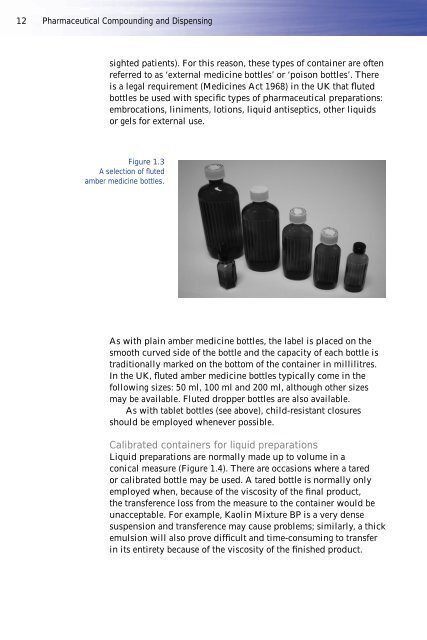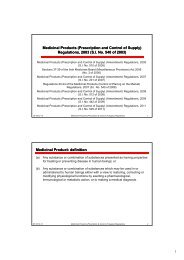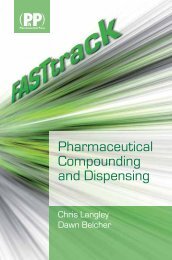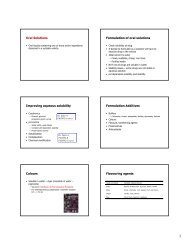Pharmaceutical Compounding and Dispensing - Pharmaceutics
Pharmaceutical Compounding and Dispensing - Pharmaceutics
Pharmaceutical Compounding and Dispensing - Pharmaceutics
You also want an ePaper? Increase the reach of your titles
YUMPU automatically turns print PDFs into web optimized ePapers that Google loves.
12<br />
<strong>Pharmaceutical</strong> <strong>Compounding</strong> <strong>and</strong> <strong>Dispensing</strong><br />
sighted patients). For this reason, these types of container are often<br />
referred to as ‘external medicine bottles’ or ‘poison bottles’. There<br />
is a legal requirement (Medicines Act 1968) in the UK that fl uted<br />
bottles be used with specifi c types of pharmaceutical preparations:<br />
embrocations, liniments, lotions, liquid antiseptics, other liquids<br />
or gels for external use.<br />
Figure 1.3<br />
A selection of fl uted<br />
amber medicine bottles.<br />
As with plain amber medicine bottles, the label is placed on the<br />
smooth curved side of the bottle <strong>and</strong> the capacity of each bottle is<br />
traditionally marked on the bottom of the container in millilitres.<br />
In the UK, fl uted amber medicine bottles typically come in the<br />
following sizes: 50 ml, 100 ml <strong>and</strong> 200 ml, although other sizes<br />
may be available. Fluted dropper bottles are also available.<br />
As with tablet bottles (see above), child-resistant closures<br />
should be employed whenever possible.<br />
Calibrated containers for liquid preparations<br />
Liquid preparations are normally made up to volume in a<br />
conical measure (Figure 1.4). There are occasions where a tared<br />
or calibrated bottle may be used. A tared bottle is normally only<br />
employed when, because of the viscosity of the fi nal product,<br />
the transference loss from the measure to the container would be<br />
unacceptable. For example, Kaolin Mixture BP is a very dense<br />
suspension <strong>and</strong> transference may cause problems; similarly, a thick<br />
emulsion will also prove diffi cult <strong>and</strong> time-consuming to transfer<br />
in its entirety because of the viscosity of the fi nished product.





